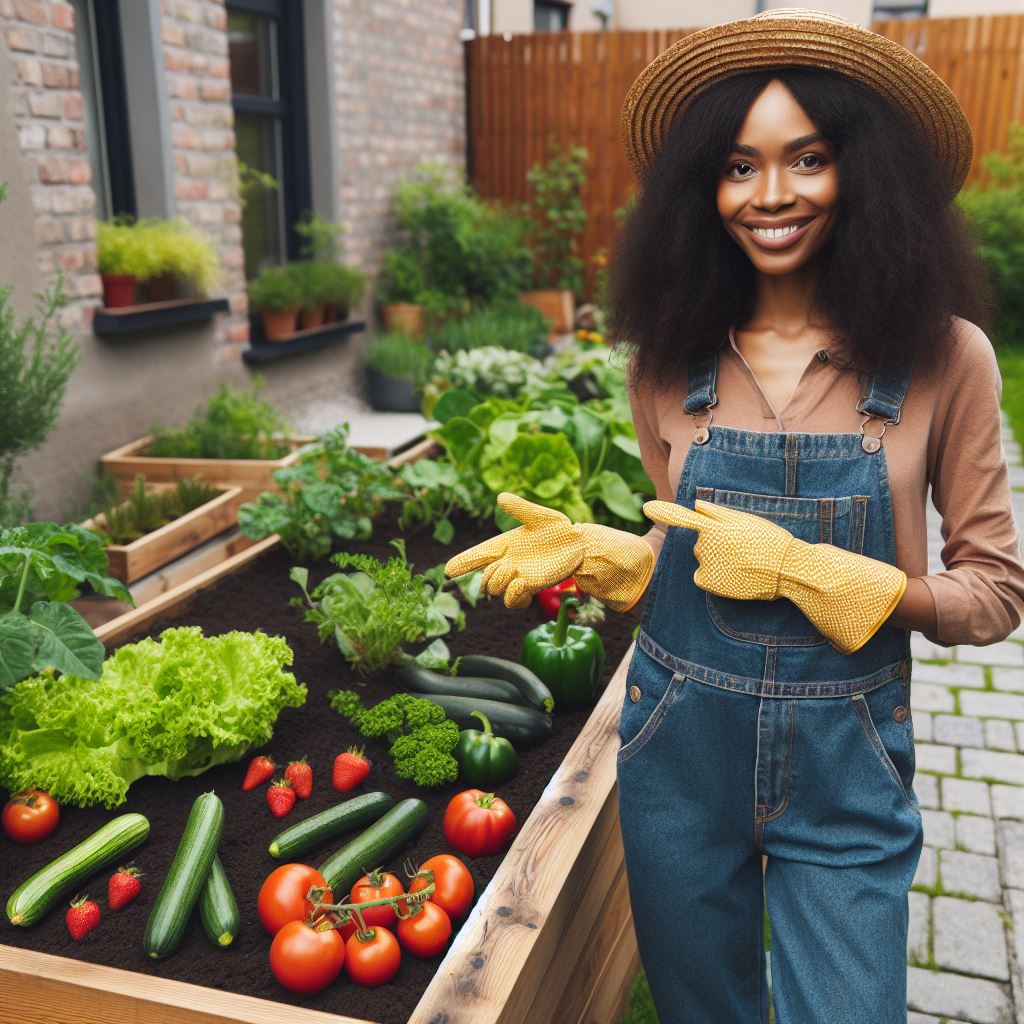Edible Landscaping: Beauty and Bounty
Last Updated on March 2, 2024
Introduction
Edible landscaping harmoniously combines ornamental and edible plants, transforming outdoor spaces into both visually stunning and productive areas.
- Definition of edible landscaping: It entails the strategic incorporation of fruit-bearing trees, bushes, and edible plants alongside traditional ornamental flora.
- Growing interest in sustainable living and organic food: Amidst rising concerns about environmental sustainability and health-conscious lifestyles, the allure of edible landscaping continues to grow.
- The combination of beauty and functionality in landscaping: Edible landscaping offers a unique blend of aesthetic appeal and practicality, where every plant serves a purpose.
With edible landscaping, your garden becomes not just a feast for the eyes but also a source of nourishment.
Imagine plucking ripe berries from a shrub or snipping fresh herbs for dinner straight from your garden.
It’s a delightful fusion of nature’s beauty and the joy of homegrown produce.
As interest in sustainable living and organic food continues to soar, edible landscaping emerges as a compelling solution, offering both environmental benefits and culinary delights.
Benefits of Edible Landscaping
Edible landscaping offers numerous benefits, ranging from environmental to economic and health advantages. Let’s explore these benefits in more detail.
Environmental Benefits
One of the significant environmental benefits of edible landscaping is reduced water consumption.
Traditional lawns require large amounts of water for maintenance, while edible plants such as fruits, vegetables, and herbs can be grown with less water.
Additionally, edible landscaping promotes biodiversity.
By planting a variety of edible crops, you attract beneficial insects, birds, and other wildlife to your garden.
This contributes to a healthier ecosystem and a more balanced natural habitat.
Another advantage is the improvement of soil health.
Growing edible plants helps nurture the soil by adding organic matter and nutrients, enhancing overall fertility and structure.
Instead of just having an aesthetically pleasing landscape, you can also contribute to the health of the soil beneath.
Economic Benefits
When it comes to economic benefits, edible landscaping can save you money on grocery bills.
By growing your own food, you are reducing the need to purchase produce from stores.
This not only saves money but also ensures a constant supply of fresh, homegrown food.
Moreover, edible landscaping provides the potential for selling surplus produce.
If you end up with more fruits and vegetables than you can consume, you can sell them or share them with neighbors and friends.
This can be a great way to earn some extra income or strengthen community bonds through food-sharing.
Health Benefits
In terms of health benefits, edible landscaping grants you access to fresh, pesticide-free food.
By growing your own fruits and vegetables, you have control over pesticide usage, ensuring that you and your family consume food that is free from harmful chemicals.
Additionally, maintaining an edible garden encourages a healthier lifestyle.
From planting and tending to the plants to harvesting and preparing the produce, edible landscaping promotes physical activity and a well-rounded, nutritious diet.
Overall, embracing edible landscaping not only beautifies your outdoor space but also provides a range of benefits.
From preserving water and promoting biodiversity to saving money on groceries and enjoying fresh, pesticide-free food, this approach harmoniously combines beauty and bounty.
So why not start incorporating edible plants into your landscaping and enjoy the numerous rewards they bring?
Read: Soil pH Matters: Testing and Adjusting Tips
Designing an Edible Landscape
Assessing available space
When it comes to designing an edible landscape, there are several factors to consider.
First and foremost, assessing the available space is essential.
Whether you have a large garden, a spacious lawn, a rooftop, or even containers, you can transform these areas into productive spaces full of beauty and bounty.
Choosing suitable plants
Once you have determined where you want your edible landscape, it’s time to choose suitable plants.
Fruit trees such as apple, pear, or citrus can not only provide delicious fruits but also add visual interest with their blossoms.
Berry bushes like blueberries or raspberries can offer a burst of color and delightful treats.
Herbs such as rosemary, thyme, or basil not only enhance the taste of your meals but also exude a lovely fragrance.
Vegetables like tomatoes, peppers, or lettuce can be interspersed throughout the landscape, adding texture and diversity.
To ensure year-round production in your edible landscape, it’s vital to understand plant lifecycles and seasonal variations.
Different plants have different growing seasons, and some may only bear fruits or vegetables during specific times of the year.
By selecting a variety of plants with varying harvest times, you can maximize your bounty throughout the year.
Additionally, succession planting is a valuable technique to consider.
By planting crops in succession, you can ensure a continuous supply of vegetables as one crop finishes and the next begins to mature.
This way, you can have a steady stream of fresh produce from your landscape without experiencing long gaps between harvests.
Planning for year-round production
Another important aspect of planning for year-round production is crop rotation.
Rotating crops helps prevent the buildup of pests and diseases in the soil while promoting balanced nutrient cycling.
By rotating the location of different plant families each season, you can maintain a healthy and productive edible landscape.
Therefore, designing an edible landscape involves assessing available space and choosing suitable plants.
Planning for year-round production requires understanding plant lifecycles, succession planting, and crop rotation.
By carefully considering these factors, you can create a vibrant and productive landscape that not only adds beauty to your surroundings but also provides a bountiful harvest for your table.
Read: Herb Gardening: Flavorful and Easy

See Related Content: Harvesting Hints for Maximum Yield
Incorporating Edible Plants into the Landscape
Creating a cohesive design
By incorporating edible plants into the landscape, you can not only create a beautiful outdoor space but also enjoy the added benefit of harvesting fresh, homegrown produce.
To successfully integrate edible plants with ornamental plants, it is important to create a cohesive design that considers factors such as color, texture, and height.
Blending edible plants with ornamental plants is essential for an aesthetically pleasing landscape.
Choose edible plants that complement the surrounding ornamentals, creating a visually pleasing composition.
For example, pair the vertical stature of fruit trees with the cascade of flowering vines to create a beautiful contrast.
Consider color when selecting edible plants for the landscape.
Incorporate vibrant fruits, such as tomatoes or berries, to add pops of color to your garden beds or containers.
Integrate leafy greens like kale or chard for a touch of rich greenery.
This color diversity adds visual interest and makes the landscape more appealing.
Texture is another factor to consider when incorporating edible plants.
Combining plants with different leaf textures, such as the smooth leaves of lettuce with the rough foliage of herbs like sage, can create an engaging sensory experience for both the eye and touch.
Strategic placement for optimal growth
When determining the placement of edible plants, strategic placement is necessary for optimal growth and productivity.
Consider the specific needs of each plant, including sun exposure and wind protection.
Ensure that edible plants receive adequate sunlight throughout the day to promote healthy growth and bountiful harvests.
Additionally, provide wind protection for more delicate plants to prevent damage.
Companion planting is a useful technique to optimize the health and productivity of edible plants.
Certain plants have natural pest-repellent properties, while others attract beneficial insects that prey on pests.
By strategically interplanting companion plants, you can create a natural defense against pests.
For example, marigolds can be interplanted with tomatoes to deter harmful insects, while attracting pollinators like bees.
Natural pest control methods
Utilize natural pest control methods to minimize the use of harmful chemicals in the edible landscape.
By attracting beneficial insects, such as ladybugs and lacewings, you can naturally control pests.
These insects feed on common garden pests, reducing the need for chemical treatments.
Additionally, certain herbs, like basil and rosemary, have strong scents that repel pests.
Most importantly, incorporating edible plants into the landscape is a rewarding and visually appealing way to enjoy the beauty of nature while harvesting fresh produce.
By following these guidelines, you can create a cohesive design that blends edible plants with ornamentals, strategically placing them for optimal growth.
Implementing natural pest control methods ensures a healthier and more sustainable gardening experience.
Read: Container Gardening: Grow Veggies Anywhere
Maintaining an Edible Landscape
Soil preparation and fertilization
Maintaining an edible landscape is crucial for ensuring a beautiful and bountiful harvest.
Proper soil preparation and fertilization play a significant role in nurturing healthy plants.
Composting is an effective way to enrich soil with essential nutrients, while mulching helps retain moisture and suppress weed growth.
Using organic fertilizers is recommended, as they are free from harmful chemicals.
They provide the necessary nutrients for plant growth and promote a safe and healthy environment for both plants and humans.
Watering and irrigation techniques
Watering and irrigation techniques are essential for a flourishing edible landscape.
Installing drip systems allows for targeted water delivery to the roots of plants, minimizing wastage.
Rain barrels can be used to collect and store rainwater, which can then be used for irrigating the landscape.
Creating efficient watering schedules ensures plants receive the right amount of hydration without overwatering.
Pruning and training edible plants
Pruning and training edible plants is another crucial aspect of maintaining an edible landscape.
Pruning promotes fruit production by removing dead or diseased branches, allowing the plant to focus its energy on producing high-quality fruits.
Additionally, managing plant size through pruning techniques ensures that the landscape remains manageable and aesthetically pleasing.
Harvesting and preserving the bounty
Harvesting and preserving the bounty is the final step in enjoying the rewards of an edible landscape.
Using proper techniques for harvesting ripe produce, such as gently twisting or cutting fruits and vegetables, ensures the plant’s health and continued growth.
Proper storage is equally important to maintain the flavor and freshness of the harvested produce.
Storing fruits and vegetables in cool, dry places or using preservation methods like canning or freezing helps extend their shelf life.
In essence, maintaining an edible landscape involves various tasks that contribute to the overall success of the garden.
From proper soil preparation and fertilization to efficient watering techniques, pruning, and harvesting, each step plays a vital role in creating a beautiful and bountiful landscape filled with delicious homegrown fruits and vegetables.
By following these practices, gardeners can enjoy the benefits of their edible landscape year after year.
Read: Small-Scale Farming: Profitable Crops Choices
Conclusion
Edible landscaping offers both beauty and bounty to any landscape.
By incorporating edible plants into your garden, you can enhance the visual appeal of your surroundings.
Additionally, the abundance of fresh and organic produce will provide a more sustainable and rewarding lifestyle.
Consider growing fruits, vegetables, and herbs that not only look stunning but also provide a source of nourishment.
Let your garden be a feast for the eyes and the table, and experience the joy of reaping what you sow.
Start small by adding a few edible plants and gradually expand your garden to create a diverse and vibrant edible landscape.
Engage in the practice of edible landscaping to enjoy the benefits of both aesthetics and sustenance.


